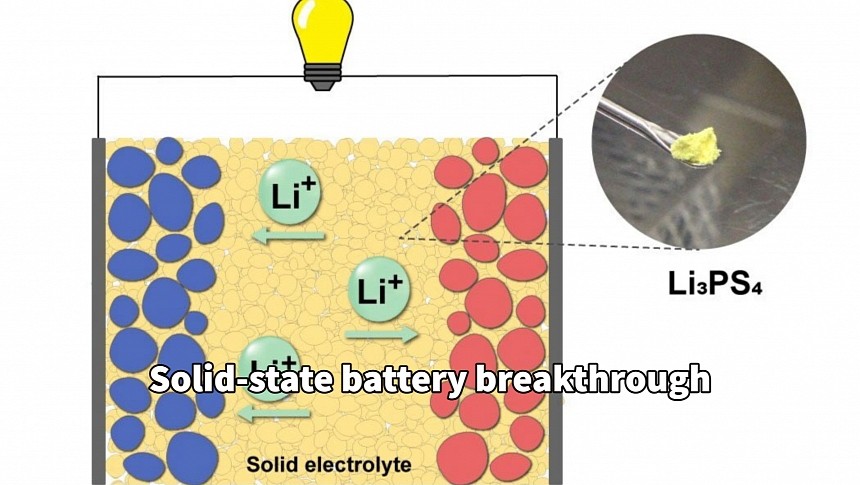Solid-state batteries promise unprecedented energy density and safety but have serious drawbacks that must be overcome. Scientists at Osaka Metropolitan University announced a significant breakthrough discovery that can speed up the adoption of solid-state batteries.
Solid-state batteries are named after their solid electrolyte, as opposed to the liquid electrolyte of the lithium-ion batteries widely used today. Solid electrolytes offer many advantages, including safety (the solid electrolyte is not flammable) and higher energy density. Finding the right solid electrolyte with high ion conductivity is paramount for advancing the development of solid-state cells.
Another problem affecting solid electrolytes is that they develop cracks during normal charging and discharging cycles. These cracks allow dendrites to penetrate between the two electrodes, eventually causing a short circuit. Dendrites are the main problem of solid-state batteries, significantly affecting their durability.
Scientists working on solid-state batteries focus on developing ways to prevent dendrite formation and advance electrolyte research. Dendrite formation research made a significant breakthrough after scientists discovered what was causing it. They also found a method to control the direction of dendrite growth, preventing them from reaching the opposite electrode. As counterintuitively as it sounds, this method involves creating more cracks in the solid electrolyte but arranged in an advantageous pattern. This way, the dendrites continue to grow but away from the opposite electrode.
Scientists at Osaka Metropolitan University have also discovered a way to make a solid electrolyte offer a very high ion conductivity at room temperature. This is unprecedented and considered a significant breakthrough in solid-state battery development, increasing battery power and decreasing recharge time. The researchers used Li3PS4, a glass-like material considered critical for all-solid-state batteries.
The material showcases varied crystal structures and proprieties depending on temperature variations. It provides high ion conductivity at high temperatures, but the challenge was to stabilize this conductivity at room temperature. The scientists found a method that allows exceptional ionic conductivity even at room temperature. To achieve this, scientists concentrated on the heating rate during crystallization. Specifically, they used rapid heating to crystalize Li3PS4 at 400 degrees Celsius (753 degrees Fahrenheit).
The promising results were published in the Journal of the American Chemical Society. The study offers hope that further development should contribute to the design of higher-performance materials.
Some companies promise the wonders of solid-state batteries today, although they are actually semi-solid batteries. These combine the advantages of both solid and liquid electrolytes but are still considered an intermediary step before solid-state cells become production-ready.
Solid-state batteries are still a distant dream, although this should not last forever. Even today's lithium-ion batteries were once considered scientists' fantasies until the technology got out of the lab and into production. Let's not forget that current Li-ion cells have made tremendous advances in durability and energy density in the past three decades since Sony began producing and selling the world's first rechargeable lithium-ion batteries.
Another problem affecting solid electrolytes is that they develop cracks during normal charging and discharging cycles. These cracks allow dendrites to penetrate between the two electrodes, eventually causing a short circuit. Dendrites are the main problem of solid-state batteries, significantly affecting their durability.
Scientists working on solid-state batteries focus on developing ways to prevent dendrite formation and advance electrolyte research. Dendrite formation research made a significant breakthrough after scientists discovered what was causing it. They also found a method to control the direction of dendrite growth, preventing them from reaching the opposite electrode. As counterintuitively as it sounds, this method involves creating more cracks in the solid electrolyte but arranged in an advantageous pattern. This way, the dendrites continue to grow but away from the opposite electrode.
Scientists at Osaka Metropolitan University have also discovered a way to make a solid electrolyte offer a very high ion conductivity at room temperature. This is unprecedented and considered a significant breakthrough in solid-state battery development, increasing battery power and decreasing recharge time. The researchers used Li3PS4, a glass-like material considered critical for all-solid-state batteries.
The material showcases varied crystal structures and proprieties depending on temperature variations. It provides high ion conductivity at high temperatures, but the challenge was to stabilize this conductivity at room temperature. The scientists found a method that allows exceptional ionic conductivity even at room temperature. To achieve this, scientists concentrated on the heating rate during crystallization. Specifically, they used rapid heating to crystalize Li3PS4 at 400 degrees Celsius (753 degrees Fahrenheit).
The promising results were published in the Journal of the American Chemical Society. The study offers hope that further development should contribute to the design of higher-performance materials.
Some companies promise the wonders of solid-state batteries today, although they are actually semi-solid batteries. These combine the advantages of both solid and liquid electrolytes but are still considered an intermediary step before solid-state cells become production-ready.
Solid-state batteries are still a distant dream, although this should not last forever. Even today's lithium-ion batteries were once considered scientists' fantasies until the technology got out of the lab and into production. Let's not forget that current Li-ion cells have made tremendous advances in durability and energy density in the past three decades since Sony began producing and selling the world's first rechargeable lithium-ion batteries.







